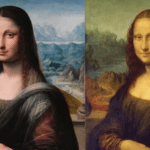 Mysteries
Mysteries  Mysteries
Mysteries  History
History 10 Surprising Stories About the Texas Rangers
 Humans
Humans 10 Philosophers Who Were Driven Mad by Their Own Theories
 Miscellaneous
Miscellaneous 10 Video-Game-Worthy Weapons and Armors from History
 Weird Stuff
Weird Stuff 10 Psychics Who Accurately Predicted Wartime Events
 The Arts
The Arts 10 Pieces of Art Inspired by a Broken Heart
 Health
Health 10 Science Fiction-Sounding New Medical Treatments
 History
History 10 Surprising Facts About the Father of Submarine Warfare
 Space
Space Ten Astonishing New Insights into Alien Worlds
 Weird Stuff
Weird Stuff 10 Bizarre Summer Solstice Rituals Still Practiced Today
 Mysteries
Mysteries Top 10 Haunting Facts About the Ghost Ship MV Alta
 History
History 10 Surprising Stories About the Texas Rangers
 Humans
Humans 10 Philosophers Who Were Driven Mad by Their Own Theories
Who's Behind Listverse?

Jamie Frater
Head Editor
Jamie founded Listverse due to an insatiable desire to share fascinating, obscure, and bizarre facts. He has been a guest speaker on numerous national radio and television stations and is a five time published author.
More About Us Miscellaneous
Miscellaneous 10 Video-Game-Worthy Weapons and Armors from History
 Weird Stuff
Weird Stuff 10 Psychics Who Accurately Predicted Wartime Events
 The Arts
The Arts 10 Pieces of Art Inspired by a Broken Heart
 Health
Health 10 Science Fiction-Sounding New Medical Treatments
 History
History 10 Surprising Facts About the Father of Submarine Warfare
 Space
Space Ten Astonishing New Insights into Alien Worlds
 Weird Stuff
Weird Stuff 10 Bizarre Summer Solstice Rituals Still Practiced Today
10 Mysterious Artists We Might Never Identify
For many artists, the creation of art is about attaching a lasting legacy to their name. But for some, anonymity means more than having their names and faces associated with what they do; they’re more than happy to fade into the background and let the work speak for itself. While perhaps the most famous of these anonymous artists is Banksy—whose work is all but priceless—there are many who follow the same path . . . while others have simply had their names lost to the centuries.
10Above

All that’s known about the street artist Above is that he’s in his mid-twenties and is a native of Northern California. He doesn’t do shows, doesn’t sell his work online, and he doesn’t even have a permanent address—perhaps because a lot of his art is done, exhibited, and installed rather illegally. If you want to see his work, you’ll have to take a few minutes out of your day and look up. If you’re fortunate enough to be in one of the countries he’s visited, you might see an arrow hanging from one of the power lines above you, pointing skyward with a single word on it. The arrows are meant to spin, revealing word pairs that mean something (like “rise” and “above”). He’s been in more than 20 countries, and each time he visits a country to do an installation, he hangs hundreds of signs.
He has said—anonymously and via email interviews—that his work is inspired by the everyday challenges we all face: rising above our lot in life, our situations, our stress, and our struggles. That seems appropriate for someone who’s gone almost a decade without a permanent address and left the US to travel Europe, create art, and to support himself by working a restaurant job. His belongings fit into a backpack. By cutting down on all the extra expenses that keep others tied down to a job, Above gets to create his art. Also a graffiti artist, he’s not afraid to make some pretty bold statements. While in South Africa, Above was commissioned to do a graffiti mural reading, “Diamonds are a woman’s best friend.” He agreed, then added a controversial “and man’s worst enemy” to the end of the message.
9The Master Of The Playing Cards

With the development of the printing press came engraving; 15th-century engraving was an art form on its own, with masters of distinctive styles who cemented the idea of printing and books as art. Among those was the “Master of the Playing Cards,” an engraver who was working in the mid-1400s. It’s thought that he was working somewhere in the region of Cologne, Germany, based on the spread of not only his works but the works of those who were influenced by him. Some of the techniques he used—like his methods of shading—have suggested that he was also a painter; those who have analyzed his body of work point to certain stylistic choices that show similarities to Japanese art.
He was dubbed the “Master of the Playing Cards” because a huge amount of his surviving works are early playing cards, designed as beautifully practical playing pieces. There are more than 70 examples of his engraved playing cards, with a wide range of subjects ranging from people and flowers to birds, deer, and even dragons. The plates were also unique in that the illustrations and the numbers were separate, meaning that the cards could be printed in a variety of combinations. Some of the images he used in playing cards have come up in other works, suggesting that his work was something of a collection of stock images. Most were done to only be printed in monochrome, but a single color engraving survives—the design of a playing card called the “Knave of Flowers,” wearing traditional court dress from that time.
8Dede

Street art is an emerging art form in many cities around the world. In Tel Aviv, it’s only become a thing relatively recently. For anonymous street artist Dede, the idea of painting on buildings and walls instead of a canvas is a way of preserving the purity of art without the interference of a gallery or critics. It’s also a way to completely and freely express ideas that might be squashed in a more formal setting.
Dede’s also well aware that street art isn’t just viewed by people on the street anymore. The Internet lets people on the opposite side of the world view a piece of street art. At the same time, that means it’s preserved in a way street art—dynamic and ever-changing by its nature—usually isn’t. Dede’s graffiti usually has characteristic elements that speak of his time performing military service that he hated. Dede signs his work with his pseudonym and a Band-Aid, and there are often Band-Aids infused in the image itself. He also favors images of peace, such as the white dove, infused into images that dominate everyday life in Israel.
7Alec Monopoly
Alec Monopoly is an American graffiti and street artist who started in New York City but eventually moved to Los Angeles, in part because of a girl and in part because the number of unattended billboards made for the perfect canvases. Alec Monopoly takes his name from one of the most prominent characters in his work. The iconic “Mr. Monopoly” was adopted as a symbol of capitalism, and not surprisingly, it’s rarely a favorable depiction. In anonymous interviews, Alec said that he was inspired to use the epic symbol of Mr. Monopoly to speak out against corporate greed and figures like Bernie Madoff.
Alec’s first real work that gained him notoriety was a piece with Madoff as the central figure, surrounded by Monopoly money. It was a powerful image at the beginning of the US recession, and it still strikes a chord with a nation struggling to recover. Afterward, Alec became increasingly paranoid that opposition in New York City was trying to stop him, going as far as to tap his phone. But since then, Alec’s only grown bolder; his move to California has resulted in artwork popping up in the most unlikely of neighborhoods, including Bel-Air and Beverly Hills—an ironic juxtaposition of his message and the wealth of the surrounding areas.
6Philadelphia Wireman

The story of the Philadelphia Wireman is a sad one. It would have been completely forgotten, lost to a Philadelphia garbage dump, if not for a man named Robert Leitch. At some point during the late 1970s or early 1980s (details are vague, because Leitch’s name was never released in connection with the Wireman until after his death), Leitch found a massive cache of objects sitting on the curb, waiting for the garbageman. They were piled on a street in a pretty shady part of town; Leitch saw something special in them, though, and piled them into his car. Once he started going through what he’d found, Leitch realized he had 1,200 individual pieces. Each piece was a wire-wrapped pocket of objects, from pens and coins to nails, food containers, toys, watches, and tools. The wire was incredibly thick and heavy, wrapped around all the objects.
At first, Leitch gave some of the objects away—until a friend convinced him to take the remaining pieces to an art gallery. That art gallery, the Fleisher Ollman Gallery, is still the custodian of a number of Philadelphia Wireman’s pieces, with some of the pieces priced at $9,000. Some of the pieces are on loan to galleries around the world, boasting a raw, heartfelt look at the below-the-poverty-line neighborhood that Wireman’s creations were found in. There’ve been a couple of assumptions made, including the idea that the artist was male (based on the thickness of the wire and the strength that would have been needed to bend it). But beyond that, no one knows anything more about him. How the cache of pieces ended up on the street and what happened to the artist himself is anyone’s guess, and the mystery behind the works has made them all that much more powerful.
5Black Hand

The Black Hand has been called “Iran’s Banksy.” The mystery street artist uses a stenciling technique similar to Banksy’s, making it possible to work very quickly and cut down the risk of being caught. The artist is also undeniably, incredibly straightforward when it comes to creating images that send a very clear message. Often, these messages couldn’t be found in a gallery even if the artist decided to go that route, as some of them are very, very dangerous. Iran is one of the few countries where the organ trade is legal. People that are hard up for money freely advertise that they’re willing to sell their organs to the highest bidder. A recent street art installment criticizing the practice was quickly destroyed before it had been up for an afternoon.
Oddly, it’s not street art itself that’s illegal in Iran. In fact, there’s a massive street art movement, but it has to involve state-sanctioned art and artists. Hence the necessity for Black Hand to stay anonymous, as he’s not about to give up his rather risky work. Most recently, one of Black Hand’s images went viral. A statement against the exclusion of women from sport, the piece showed a woman in the Iranian national football jersey, holding a trophy over her head. But instead of the typical sporting trophy, she held a bottle of dish soap in her rubber-gloved hands.
4The Master Of The Furies

So little is known about the so-called “Master of the Furies” that his existence wasn’t even established until the 1970s. Erwin Neumann, curator at the Kunsthistorisches Museum in Vienna, began assembling breathtakingly detailed, amazingly lifelike ivory carvings. After a careful analysis of the sculptures, he determined they were all the work of one man, whom he dubbed the “Master of the Furies,” after the characteristics he saw in many of the works. The sculptures were from sometime in the early 17th century and were most likely done in Salzberg, Austria. Beyond that, nothing is known about the mysterious man whose work had been scattered, and many of the sculptures could still be undiscovered.
So far, art historians have attributed 25 pieces to the nameless man of the 1600s. The pieces are all incredibly detailed and eerily lifelike; many resemble ancient works of art from Greece, with their long, flowing robes and definite aura of movement. The carvings are so exacting and precise that even muscles, arteries, and veins can be seen in the straining and moving figures. Each strand of hair captures motion; open-mouthed figures grimace in silent screams. It seems highly likely that there are still sculptures out there by this long-forgotten master. The Victoria and Albert Museum in London has one carving that seems to prove there are missing figures; theirs is a depiction of Adam that curators believe was once partnered with Eve—who is still missing.
3Scotland’s Mystery Book Sculptor
In 2011, a series of sculptures were sent to different locations around the city of Edinburgh. All the locations that received a sculpture were in some way related to literacy, from the Scottish Poetry Library to author Ian Rankin. The first one was found on a table in the poetry library, and it wasn’t just exquisite, it was very appropriate. It consisted of a tree that was carefully assembled from a book, mounted on another book. There was also a broken eggshell, filled with scraps of paper that were bits of the poem “A Trace of Wings.” There was a tag with a cryptic message of thanks, presenting it to the library in support of “libraries, books, words, ideas.”
The next one showed up at the National Library of Scotland, and it was a similarly created sculpture of a coffin and a gramophone. It was created from a copy of one of Ian Rankin’s books. Rankin himself appeared in the next sculpture, which was delivered to a cinema called the Filmhouse. It was of a cinema theater and featured a little paper Rankin sitting in the audience. In the end, 10 paper book sculptures were delivered to various institutions around Scotland, with the 11th one being delivered to Rankin himself.
The mystery was almost solved when one member of the Edinburgh Evening News supposedly recognized the work of an artist he’d purchased something from before. Rather than outright naming the person—who clearly wanted to remain anonymous—the paper took a poll of its readers on whether or not the mysterious artist should be outed. Readers voted to keep the artist anonymous, and the guess—whether right or wrong—was never published. The sculptor, who has only been identified as being female, isn’t going away, either. In 2012, more book sculptures cropped up for Book Week Scotland.
2The Toynbee Tiles
While you need to be looking up to see the work of the artist known as “Above,” you’ll need to be looking down to see the Toynbee Tiles. Since 1985, tiles roughly the size of a license plate have been popping up across the Western Hemisphere. They’re created by making a sandwich of linoleum, tar paper, and asphalt crack filler; applied to the road, they’re originally hidden by the paper, which wears away well after the tile is set permanently into the road. There are about 450 tiles in roads throughout the United States and Canada, with a couple even showing up in South America. It’s not known who’s making them, whether it’s the work of one person or a handful of people, and it’s definitely not even known what they mean or what message they’re trying to get across. They all contain words and phrases that are almost poetry and are always cryptic, like the one that reads, “TOYNBEE IDEA / IN MOVIE 2001 / RESURRECT DEAD / ON PLANET JUPITER.”
Most have text that’s some variation of that cryptic sentiment, which makes them even more baffling—someone out there is clearly trying to get a message across. A lot of the tiles include the word “Toynbee,” which is what’s given them their name. It’s been suggested that it’s a reference to British historian Arnold Toynbee, whose work focused mainly on the rise and fall of different societies throughout history. His work was on a rather epic scale: He looked at history in terms of entire cultures, societies, and civilizations as players in a global production and studied why things that define one society are rejected by another. That doesn’t help the tiles make any more sense. In 2011, the mystery documentary Resurrect Dead: The Mystery of the Toynbee Tiles attempted to shed light on the tiles, their cryptic meaning, and their mystery artist.
1Skid Robot
The most meaningful art is art that changes the way we see the world. The street art and graffiti of one anonymous artist isn’t just changing the way people see the world around them, but it’s making us notice those that are all too often overlooked. The artist goes by the name of “Skid Robot.” He works in Los Angeles, and he doesn’t just create murals or draw graffiti—he draws the hopes and dreams of the homeless that live on the city’s streets, often incorporating the people themselves into the murals. His Instagram is filled with photos of those homeless people, their stories, and the artwork that he creates behind them. Sometimes, it’s as simple as a dream bubble over their heads that might be a turkey dinner or a real bed. Other times, he draws an entire room behind them. One of the most moving of his (or her) posts was that of a wheelchair-bound man, homeless and unable to walk after being shot in the back. Skid Robot drew the man a throne.
The artist isn’t just drawing attention to the men and women living on the street, he’s lending a helping hand where he can, too. He’s given them hot meals and fresh water. One of them—the young man confined to a wheelchair—declined food but asked for a few pens and a sketchbook instead, saying that art used to be his escape. According to Skid Robot, his goal is to give those without a voice a way to speak out and to see their hopes and dreams . . . if only on a wall behind them. Art is about raising awareness, and art can change the world.








